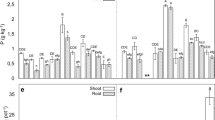Abstract
Plant growth performance, the P content in root and nodule tissues, and nodulation and N2-fixing ability were studied in four provenances of Acacia mangium from Papua New Guinea following different levels of P fertilizer application. A. mangium did not seem to need high levels of P for growth and N2 fixation. The response by this leguminous tree to the P supply varied significantly according to provenance and to P concentrations in the culture solution. The provenances of A. mangium were classified into three types according to their P response: (1) Growth performance, nodulation, and N2 fixation of plants were stimulated as concentrations of P increased (provenance PH 482); (2) the maximal effect of P on plant growth was found only at P concentrations higher than 500 μM (provenance PH 484); and (3) the plant response to P fertilization was low, even with nutrient solutions containing P concentratins higher than 500 μM (provenances PH 483 and PH 485). Provenance PH 483 was distinguished by its low nodulating ability. However, this provenance grew well, probably because of its high N2 fixation efficiency as expressed by specific acetylene reduction activity and its high P content in nodule tissues. Therefore, in certain cases, these two parameters may be useful criteria in selecting leguminous plants for field use. Statistical analyses of the study results showed that the effect of the factor P supply on N2 fixation efficiency and nodule development was only significant at P concentrations lower than 250 μM whereas the effect of the factor plant provenance was significant regardless of the P concentration used. This observation emphasizes the value of provenance screening in the identification of plants for use in a wide range of soil types.
Similar content being viewed by others
References
Awonaike KO, Hardarson G (1992) Biological nitrogen fixation of Gliricidia sepium/Rhizobium symbiosis as influenced by plant genotype, bacterial strain and their interaction. Trop Agric 69: 381–385
Barnet YM, Catt PC (1991) Distribution and characteristics of root-nodule bacteria isolated from Australian Acacia spp. Plant Soil 135: 109–120
Bremner JM, Mulvaney CS (1982) Nitrogen-total. In: Page AL, Miller RH, Keeney DR (eds) Methods of soil analysis. Part 2. Chemical and microbiological properties. Am Soc Agron, Madison, Wis, pp 595–624
Chittachumnonk P, Sirilak S (1991) Perfomances of Acacia species in Thailand. In: Turnbull JW (ed) Advances in tropical acacia research. Australian Centre for International Agricultural Research, Canberra, Proceedings 35: 153–158
Danso SKA, Bowen GD, SangingaN (1992) Biological nitrogen fixation in trees in agroecosystems. Plant Soil 14: 177–196
Föhse D, Claassen N, Jungk A (1988) Phosphorus efficiency of plants. I. External P requirement and P uptake efficiency of different plant species. Plant Soil 110: 101–109
Galiana A (1990) La symbiose fixatrice d'azote Acacia mangium-Bradyrihizobium. Thèse de Doctorat, Université de Paris
Hardy RW, Holsten RD, Jackson EK, Burns RC (1968) The acetylene-ethylene reduction assay for the N2-fixation. Laboratory and field estimation. Plant Physiol 43: 1185–1207
Harwood CE, Williams ER (1992) A review of provenance variation in growth of Acacia mangium. In: Canon LT, Akan KM (eds) Breeding technologies for tropical acacias. Australian Centre for International Agricultural Research, Canberra. Proceeding 37: 22–23
Jakobsen I (1985) The role of phosphorus in nitrogen fixation by young pea plants (Pisum sativum). Physiol Plant 64: 190–196
Liang SB, Gan E (1991) Performances of Acacia species on four sites of Sabah Forest Industries. In: TurnbullJW (ed) Advances in tropical acacia research. Australian Centre for International Agricultural Research, Canberra. Proceedings 35: 159–165
Murphy J, Riley JP (1962) A modified single solution method for the determination of phosphate in natural waters. Anal Chim Acta 27: 31–36
National Academy of Sciences (1983) Mangium and other fast growing Acacias for the humid tropics. National Academy Press, Washington, DC
Robson AD, O'Hara GW, Abbott LK (1981) Involvement of phosphorus in nitrogen fixation by subterranean clover (Trifolium subterraneum L.) Aust J Physiol Plan 8: 427–436
Sanginga N, Danso SKA, Bowen GD (1992) Variation in growth, sources of nitrogen and N-use efficiency by provenances of Gliricidia sepium. Soil Biol Biochem 24: 1021–1026
Sun JS, Simpson RJ, Sands R (1992) Nitrogenase activity of two genotypes of Acacia mangium as affected by phosphorus nutrition. Plant Soil 144: 51–58
Turnbull JW (1987) Acacia mangium. A fast growing tree for the humid tropics. Nitrogen-fixing Tree Highlights 87-04
Author information
Authors and Affiliations
Rights and permissions
About this article
Cite this article
Vadez, V., Lim, G., Durand, P. et al. Comparative growth and symbiotic performance of four Acacia mangium provenances from Papua New Guinea in response to the supply of phosphorus at various concentrations. Biol Fertil Soils 19, 60–64 (1995). https://doi.org/10.1007/BF00336348
Received:
Issue Date:
DOI: https://doi.org/10.1007/BF00336348




